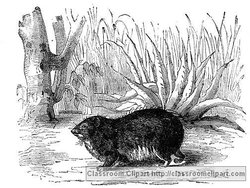Hyrax
|
|
| Hyraxes | ||||||||||
|---|---|---|---|---|---|---|---|---|---|---|
| | ||||||||||
| Scientific classification | ||||||||||
| ||||||||||
| Genera | ||||||||||
|
Procavia |
A hyrax is any of about 11 species of fairly small, thickset, herbivorous mammals in the order Hyracoidea. They are short-legged, rotund creatures with a mere stump for a tail; well-furred and about the size of a domestic cat. Most are between 30 and about 70 cm long and weigh between 2 and 5 kg. From a distance and with a little imagination, a hyrax could be mistaken for a very well-fed rabbit—indeed, early Phoenician navigators mistook the rabbits of the Iberian Peninsula for hyraxes: the word Spain originally came from an ancient term meaning "land of the hyraxes."
| Contents |
Prehistoric hyraxes
All modern hyraxes are members of the family Procaviidae (the only family in the Hyracoidea), and they are found only in Africa and the Middle East. In the past, however, hyraxes were widespread and common. The order first appears in the fossil record over 40 million years ago, and for many millions of years hyraxes played a prominent role as the primary terrestrial herbivore in Africa, just as odd-toed ungulates did in North America. There were many different species, the largest of them about the weight of a small horse.
During the Miocene, however, competition from the newly-developed bovids—very efficient grazers and browsers—pushed the hyraxes out of the prime territory and into marginal niches. Nevertheless, the order remained widespread, diverse and successful as late as the end of the Pliocene (about two million years ago) with representatives throughout most of Africa, Europe and Asia.
The large size of prehistoric hyraxes can help us to appreciate the remarkable fact that modern hyraxes may be the closest living relatives of the elephant. The descendants of the giant hyracoids evolved in different ways. Some became smaller, and gave rise to the modern hyrax family. Others appear to have taken to the water (perhaps like the modern capybara), and ultimately gave rise to the elephant family, and perhaps also the Sirenians (dugongs and manatees). Strange though this theory may seem, DNA evidence supports it, and the small modern hyraxes share numerous features with elephants, such as toenails, sensitive pads on their feet, small tusks, and the shape of some of their bones.
Hyraxes today
Present-day hyraxes retain a number of early mammal characteristics; in particular they have poorly developed internal temperature regulation (which they deal with by huddling together for warmth, and by basking in the sun like reptiles). Unlike other browsing and grazing animals, they do not have well developed incisors at the front of the jaw for slicing off leaves and grass, and need to use the teeth at the side of the jaw instead. Unlike the even-toed ungulates and some of the macropods, hyraxes do not chew cud to help extract nutrients from coarse, low-grade leaves and grasses. They do, however, have complex, multi-chambered stomachs which allow symbiotic bacteria to break down tough plant materials, and their overall ability to digest fibre is similar to that of the ungulates.
- ORDER HYRACOIDEA
- Family Procaviidae
- Genus Procavia: rock hyraxes or dassies
- Abyssinian Hyrax, Procavia habessinicus
- Cape Hyrax, Procavia capensis
- Johnston's Hyrax, Procavia johnstoni
- Kakoveld Hyrax, Procavia welwitschii
- Western Hyrax, Procavia ruficeps
- Genus Heterohyrax: bush hyraxes
- Ahaggar Hyrax, Heterohyrax antineae
- Yellow-spotted Hyrax, Heterohyrax bruceii
- Matadi Hyrax, Heterohyrax chapini
- Genus Dendrohyrax: tree hyraxes
- Eastern Tree Hyrax, Dendrohyrax validus
- Southern Tree Hyrax, Dendrohyrax arboreus
- Western Tree Hyrax, Dendrohyrax dorsalis
- Genus Procavia: rock hyraxes or dassies
- Family Procaviidae
Clipart and Animal Pictures
- Clipart (https://classroomclipart.com/image/category/clipart.htm)
- Animal Clipart (https://classroomclipart.com/image/category/animal-clipart.htm)
- Animal Animated Clipart (https://classroomclipart.com/clipart/Animations/Animals.htm)
- Pictures of Animals (https://classroomclipart.com/image/category/animal-photos.htm)
- Amphibian Clip Art, Pictures and Photogaphs (https://classroomclipart.com/image/category/amphibian-clipart.htm)
- Farm Animal Clip Art, Pictures and Photographs (https://classroomclipart.com/image/category/farm-animal-clipart.htm)
- Mammal Clip Art, Pictures and Photographs (https://classroomclipart.com/image/category/mammal-clipart.htm)
- Marine Animal Clip Art, Pictures and Photographs (https://classroomclipart.com/image/category/marine-life-clipart.htm)
- Reptile Clip Art, Pictures and Photographs (https://classroomclipart.com/image/category/reptile-clipart.htm)
- Spider Clip Art, Pictures and Photographs (https://classroomclipart.com/image/category/spider-clipart.htm)
External links
- A BBC Science and Nature article on Hyrax (http://www.bbc.co.uk/nature/animals/features/155index.shtml)
- A reference to Hyrax on a website about elephants (includes video of Procavia capensis) (http://elephant.elehost.com/About_Elephants/Stories/Evolution/evolution.html)
| Mammals |
|---|
| Monotremata |
|
Placentalia: Xenarthra | Dermoptera | Desmostylia | Scandentia | Primates | Rodentia | Lagomorpha | Insectivora | Chiroptera | Pholidota | Carnivora | Perissodactyla | Artiodactyla | Cetacea | Afrosoricida | Macroscelidea | Tubulidentata | Hyracoidea | Proboscidea | Sirenia |
|
Marsupialia: Didelphimorphia | Paucituberculata | Microbiotheria | Dasyuromorphia | Peramelemorphia | Notoryctemorphia | Diprotodontia |


